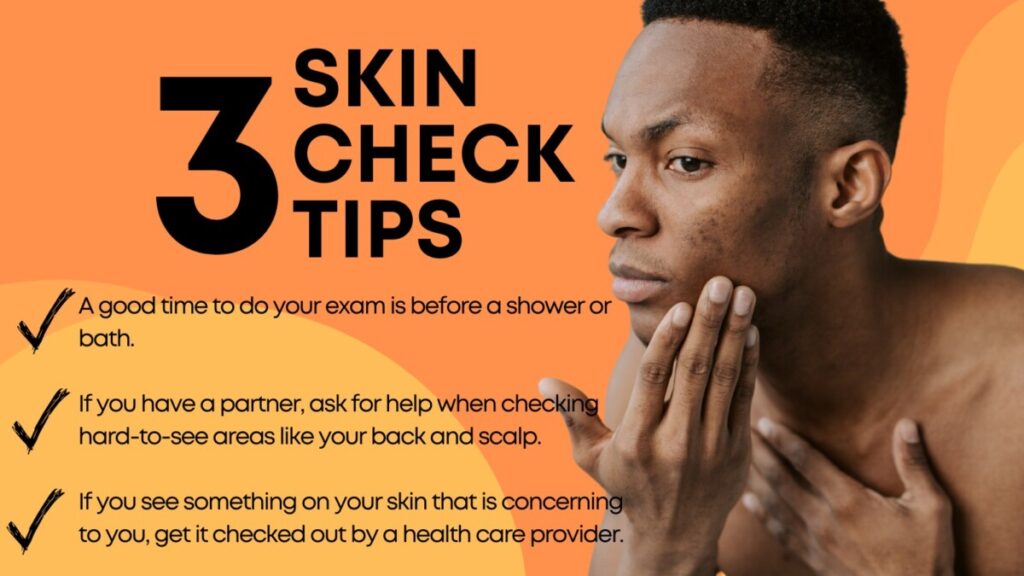
How Do I Detect Skin Cancer?
Preventive measures such as sunscreen and protective clothing are critical for protecting your skin, but early detection of skin cancer is equally important. Finding skin cancer before it can grow and spread is the goal. Skin checks—both self-examinations and those performed by your medical provider—are key to detecting skin cancer early, regardless of whether your skin is lighter or darker in tone.
Perform Regular Skin Self-Examinations
Performing regular self-examinations of your skin is a simple yet effective way to monitor any changes that may indicate skin cancer. Before you begin self-exams, it is recommended to see a healthcare provider for a complete skin exam to establish a baseline of what is considered “normal” for your skin. This will help you identify any new or changing moles or spots during your monthly self-exams.
The guidelines for a skin self-exam for people with skin of color are similar to those with lighter skin tones: Look for anything on your skin that is symptomatic—anything that unexplainably itches, bleeds, or crusts—and any new or changing lesion or spot.
In addition to performing regular self-examinations, it is important to see a healthcare provider annually for a professional skin exam. Dermatologists are trained to identify early signs of skin cancer that may not be noticeable to the untrained eye. By combining self-exams with professional exams, you can increase the likelihood of detecting skin cancer in its early stages when treatment is most effective.
Regardless of whether your skin tone is lighter or darker, everyone should be vigilant about monitoring their skin for signs of skin cancer. While fair-skinned individuals are at higher risk for developing skin cancer due to their lower levels of melanin (the pigment that gives color to the skin), people with darker skin tones are not immune to this disease.
Skin cancer can develop on anyone regardless of their ethnicity or background. Therefore, it is important for everyone to take proactive steps in monitoring their own health and seeking medical attention if they notice any changes in their skin.
What To Look For
- Something new, different, or changing, such as a dark spot or patch that is growing or continually bleeding
- A spot that takes longer than two weeks to heal
- A sore that comes back after it seemed to heal
- Rough or dry patches of skin
- A dark line in or below a fingernail or toenail
- A dark spot inside your mouth

More Helpful Tips
- Choose a day that is easy to remember to perform your exam, such as the first day of the month.
- Take note of the patterns of moles and blemishes on your skin to better compare and track changes in the following months. If possible, take photos.
- Go through each of the steps below every month. Do the exam the same way each time, so you don’t miss any part of your body.
- Find a spot with a full-length mirror, a hand-held mirror, a blow dryer, a chair to sit on, and a well-lighted area.

1. Your Tools: You will need a full-length mirror, a hand-held mirror, a blow dryer, a chair to sit on, and a well-lighted area.

2. Your Face: Carefully examine your face, especially your nose, lips, mouth, and ears – front and back. Check inside your mouth.

3. Your Scalp: Thoroughly examine the entire surface of your scalp, using a blow dryer and mirror to expose each section to view.

4. Your Front Torso: Facing the full-length mirror, inspect your neck, chest, and abdomen. Women: check the skin underneath each breast. Lift your arms and check the sides of your upper body as well. Check your palms and fingernails.

5. Your Back Torso: Face away from the full-length mirror, holding the handheld mirror. Examine your back, your shoulders, the back of your neck, and any other area you could not see from the front. From there, continue down your body and examine your buttocks and the backs of your thighs.

6. Your Lower Body: Sit on a chair and scan your legs using the handheld mirror to look at the back of each leg. Check the tops and soles of your feet, making sure to check your toenails and between your toes. Use the handheld mirror to check your genitals and the insides of your thighs.
Early detection plays a crucial role in successfully treating and managing skin cancer. By performing regular self-examinations and seeking professional evaluations when necessary, you can increase the chances of catching this disease in its earliest stages when treatment options are most effective. Remember that prevention starts with protection – wear sunscreen and protective clothing – but detection starts with awareness and vigilance over your own body’s changes.
